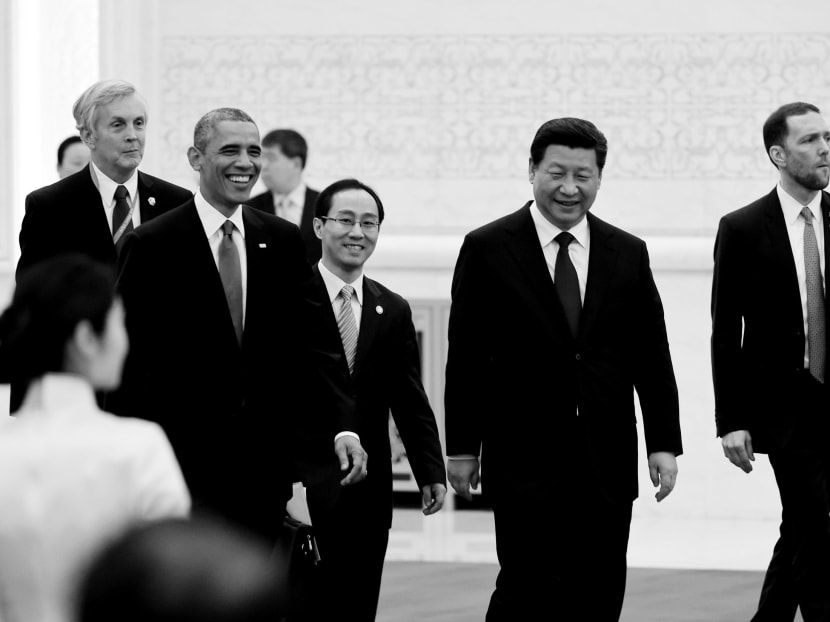Why the US should include China in TPP
On Monday, United States President Barack Obama signed into law legislation that was passed by Congress last week giving him the authority to “fast-track” negotiations for the Trans-Pacific Partnership (TPP), a proposed regulatory and investment treaty among 12 countries in the Pacific Rim that will cover 40 per cent of the world’s economy and raise global economic output by nearly US$300 billion (S$404 billion) annually.

Chinese President Xi Jinping (2nd R) and U.S. President Barack Obama arrive for a lunch banquet in the Great Hall of the People in Beijing November 12, 2014. Photo: Reuters
On Monday, United States President Barack Obama signed into law legislation that was passed by Congress last week giving him the authority to “fast-track” negotiations for the Trans-Pacific Partnership (TPP), a proposed regulatory and investment treaty among 12 countries in the Pacific Rim that will cover 40 per cent of the world’s economy and raise global economic output by nearly US$300 billion (S$404 billion) annually.
The TPP has been a cornerstone of Mr Obama’s foreign-policy pivot to Asia. But opposition from Mr Obama’s Democrat Party to the fast-track Bill has triggered fears of America’s absence from the Pacific at a time when rules for the international order are being rewritten.
As though reality had finally set in, US lawmakers made a dramatic U-turn on the very week that top Chinese officials were in Washington for the annual US-China Strategic and Economic Dialogue.
Given the importance of the TPP, why is the US leaving China out of it?
THE CHINA QUESTION
Most of the resistance to China’s entry to TPP stems from concerns among its members: Developing TPP markets fear the erosion of their cost advantage, while advanced economies fear the prospect of job losses.
The harshest opposition to China’s involvement in TPP comes from the US. American officials have underlined the need for prospective members to meet conditions such as rigorous labour standards, environmental clauses, intellectual property protection and other standards that countries such as China do not meet.
Though this could be seen as Washington’s attempt to foster a high-quality trade regime, bitter perceptions among the American public surrounding the aftermath of China’s entry into the World Trade Organization in 2001 probably add to the resistance.
Some research suggests that more than two million of the five million US factory jobs that were lost since 2000 were traceable to low-cost imports. And so, the TPP has become a strategy to “contain” the “China bogeyman”.
Despite the anti-China rhetoric, Beijing has expressed interest in being part of the TPP. Mr Obama said early last month that Chinese officials have reached out to Washington and suggested Beijing does not want to be left out of the TPP’s comprehensive scale and scope.
At the same time, pundits warn that China is already forming alternative arrangements such as the Regional Comprehensive Economic Partnership and the Asian Infrastructure Investment Bank to bolster its influence in the Pacific, in case its membership to the TPP does not materialise.
If China and the US continue to push for unilaterally biased regional orders, friction is bound to surface.
There are other reasons for the US to include China in the TPP.
First, for America, the Peterson Institute predicts that China’s membership in the TPP could grow US exports by 13 per cent, and result in additional output of US$170 billion a year — nearly a full percentage point of US gross domestic product.
Second, TPP members will gain access to more sectors in the Chinese economy dominated by state-owned enterprises. As an economy moving up the value chain, China will stand to benefit from these foreign direct investments (FDIs), too.
Third, the incentives for joining the TPP might hasten China’s internal reforms, to the benefit of the world at large. Chinese President Xi Jinping’s administration has designated “deepening market reform” a top policy, which is a timely convergence with the TPP’s requirements.
The prospect of joining the TPP could provide China with the necessary boost to its domestic economic reforms in the state sector, labour and environmental areas .
Finally, precedence on multilateral engagements demonstrates that the TPP is an opportunity to co-create a more peaceful Pacific order.
Between 1405 and 1433, China launched one of history’s most remarkable nautical expeditions to sovereignties as far as Java, India, the Horn of Africa and the Strait of Hormuz.
The engagement created favourable conditions for merchants through an early exercise of “soft power”, which resulted in immeasurable goodwill among these societies. Similarly, America is largely credited with the Asian Economic Miracle in the 1980s and 1990s, through capitalist development that set the preconditions for Japan’s meteoric resurgence, and the birth of the four Asian Tigers — Taiwan, Singapore, South Korea, and Hong Kong. Goodwill for America still lingers: A 2014 Pew Research poll shows that the US enjoys a high level of support from Asian countries, including the Philippines, South Korea and even Vietnam.
Former US President Richard Nixon’s lead interpreter in his first China trip, Mr Charles Freeman, has a good analogy on how nations tend to exercise political capital as national games: “Americans play football, games that are entirely tactical. The Chinese like to play ‘wei qi’, a protracted game of encirclement”, that converts short-term losses into long-term gains.
Giving China a meaningful stake in the TPP might enable Washington and Beijing to realise the long-term gains of a Pacific at peace.
ABOUT THE AUTHOR:
Marcus Loh is an associate director of a global public relations firm, and an advisor at the UOB-SMU Asian Enterprise Institute at the Singapore Management University.






